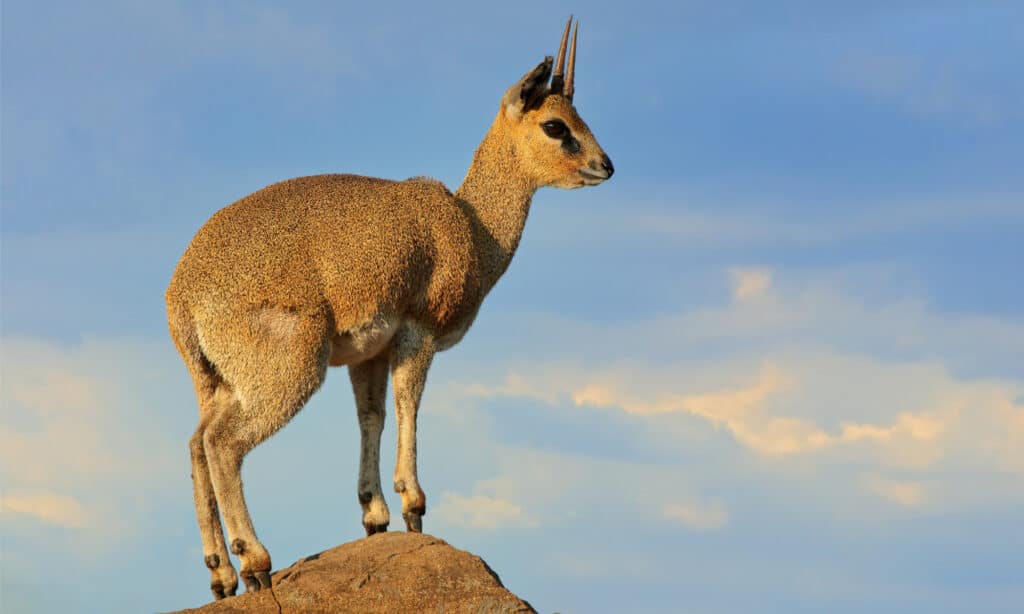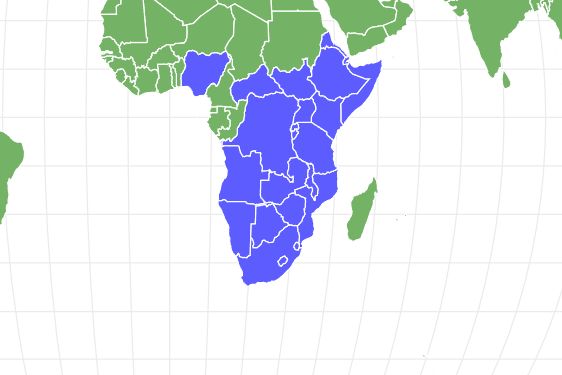Klipspringer
Oreotragus oreotragus
Klipspringers can jump as high as 10-12ft!
Advertisement
Klipspringer Scientific Classification
- Kingdom
- Animalia
- Phylum
- Chordata
- Class
- Mammalia
- Order
- Cetartiodactyla
- Family
- Bovidae
- Genus
- Oreotragus
- Scientific Name
- Oreotragus oreotragus
Read our Complete Guide to Classification of Animals.
Klipspringer Conservation Status
Klipspringer Facts
- Name Of Young
- Calf
- Group Behavior
- Family units
- Solitary/Pairs
- Pair
- Small families
- Fun Fact
- Klipspringers can jump as high as 10-12ft!
- Estimated Population Size
- 42000
- Biggest Threat
- Hunting
- Most Distinctive Feature
- Their tiny hooves
- Distinctive Feature
- Their course, hollow hair that rustles when shaken
- Other Name(s)
- Oreotragus oreotragus
- Gestation Period
- 6 months
- Temperament
- Territorial
- Litter Size
- 1
- Habitat
- Desert, rocky areas, savannah, shrublands
- Diet for this Fish
- Herbivore
- Average Litter Size
- 1
- Lifestyle
- Diurnal/Nocturnal
- Day and Night
- Favorite Food
- Succulents, fruits, flowers
- Common Name
- Klipspringer
- Number Of Species
- 10
- Location
- Angola, Botswana, Central African Republic, DR Congo, Djibouti, Eritrea, Swaziland, Ethiopia, Kenya, Malawi, Mozambique, Namibia, Nigeria, Rwanda, Somalia, South Africa, South Sudan, Tanzania, Uganda, Zambia, Zimbabwe, Burundi, Lesotho
Klipspringer Physical Characteristics
- Color
- Brown
- Grey
- Yellow
- Olive
- Skin Type
- Fur
- Lifespan
- 15 years
- Weight
- 22-40lb
- Height
- 16.9-20 inches
- Length
- 29.5-45 inches
- Age of Sexual Maturity
- 7 months to 12 months
- Age of Weaning
- 4-5 months
- Venomous
- No
- Aggression
- Low
View all of the Klipspringer images!
Klipspringers are monogamous and mate for life.
Klipspringers derived their names from the Afrikaans language, and their name is directly translated to “rock jumper.” This is due to their unique ability to navigate their rocky habitat by jumping from rock to rock. They are fiercely loyal animals and live in pairs and in small families. You will find them in Sub-Saharan Africa, where their preferred habitats include desert, rocky areas, savannah, and shrublands.
5 Incredible Klipspringer Facts
- Klipspringers have thick, hollow fur that insulates their bodies and acts as a shield, protecting the tiny antelope from its rugged terrain.
- The klipspringer’s hooves are petite and point downward in a cylindrical shape, making it look like they are walking on their tippy-toes.
- Klipspringers are similar to humans, forming life-long pairs. These couples will browse together and take turns being on the lookout. Then, if one senses danger, it will let out a piercing whistle through the nose, causing its mate to return the alarm call. Next, both of them will flee to higher ground.
- Klipspringers always have to be on the lookout because several predators, including jackals, eagles, leopards, spotted hyenas, caracals, and baboons, can ambush them on the rocky koppies (South African for “small hill”).
- Where they live determines if they have horns or not. For example, in Southern Africa, only males have horns. However, in Eastern Africa, both males and females have horns. This is due to there being more competition between themselves for resources in the east.
Klipspringer Scientific Name
The klipspringer’s scientific name is Oreotragus oreotragus, a small antelope genus. Its common name, klipspringer, is derived from the Afrikaans language meaning “rock jumper.” They belong to the family Bovidae, which includes animals like:
In addition, they form part of the same class as humans, Mammalia. Characteristics of mammals include:
- They are warm-blooded
- They give birth to their young
- They have mammary glands that produce milk
- They have fur that protects them from the elements
Scientists have discovered 11 sub-species, namely:
- Noack’s or southern Tanzanian klipspringer
- Golden klipspringer
- Zambian klipspringer
- Cape klipspringer
- Western klipspringer
- Ethiopian klipspringer
- Maasai klipspringer
- Somali klipspringer
- Stevenson’s klipspringer
- Transvaal klipspringer
- Angolan klipspringer
Klipspringer Appearance and Behavior
The klipspringer is a tiny antelope that stands at the height of 2 feet tall and weighs between 20-40 pounds. The males have hollowed-out horns, and depending on their location; females also have horns. In Southern Africa, females are born without horns; however, they develop horns to defend themselves from a significant amount of competition among klipspringer for resources in the eastern territories.
Its fur is bristle-like and thick, but the hairs are hollow and make a rustling noise when shaken. Their hair acts as insolation from the severe climate and protection from the harsh terrain. They come in various colors depending on their location, but grey, yellow, and brown are the most common.
But, the klipspringer’s most prominent characteristic is its tiny hooves shaped like cylinders, making it appear to be standing on its tippy-toes. These dainty hooves are the size of a dime but provide the klipspringer with the agility it needs to navigate the rocky slopes.
Klipspringers live in pairs or small family groups. They are very territorial, but otherwise, they are very shy animals. If threatened, they will give off a warning whistle through the nose, and flee to a safe location with their partners. To show affection when greeting, they rub against each other’s cheeks.
Klipspringers can jump between 10-12 feet in the air and often stand on their hind legs to reach tall branches. The sub-species in Namibia have also been seen climbing in trees up to 17 feet 9 inches high.

Klipspringers are 2 feet tall and weigh between 20-40 pounds.
©iStock.com/EcoPic
Klipspringer Habitat
Klipspringers can be found scattered across Africa, with sub-species extending from Sudan all the way down to South Africa. They prefer rocky areas where they can quickly flee from predators by seemingly jumping from rock to rock. Klipspringers can survive at high altitudes (up to 15,000 ft), and they are even found on the slopes of Mount Kilimanjaro.
They prefer hot or arid regions with sparse vegetation and koppies (rocky hills). They are primarily nocturnal and rest during the hottest time of the day.
Klipspringer Locations
- Angola
- Botswana
- Burundi
- Central African Republic
- Democratic Republic of Congo
- Djibouti
- Eritrea
- Eswatini
- Ethiopia
- Kenya
- Lesotho
- Malawi
- Mozambique
- Namibia
- Nigeria
- Rwanda
- Somalia
- South Africa
- South Sudan
- Tanzania
- Uganda
- Zambia
- Zimbabwe
Klipspringer Diet
Klipspringers are herbivores and can survive on a wide selection of vegetation, and by consuming a large number of succulents, their need for water significantly decreases.
What do Klipspringers Eat?
Klipspringers primarily survive on succulents; however, they also eat flowers, fruit, shrubs, grass, seeds, and forbs.
What Eats Klipspringers?
Klipspringers are preyed upon by various carnivores like leopards, baboons, spotted hyenas, eagles, caracals, and jackals.
Klipspringer’s Predators and Threats
Klipspringers always need to be on the lookout because they have a lot of predators. They need to worry about big cats and hyenas from the ground and from above, the eagle. Their calves fall victim to baboons and snakes as well.
Predators will have to ambush these stealthy antelopes because they usually have a lookout and flee before anything can get too close.
Klipspringers are of least concern on the IUCN Redlist. Therefore, there are no plans in place to protect this timid species as yet.
Reproduction, Babies, and Lifespan
Just like the dik-dik, klipspringers live in monogamous pairs and mate for life. The female comes into sexual maturity between the age of 7 months to 1 year, and their gestation period lasts for about six months. Their mating season occurs every 16 months, usually between the months of August and September.
They give live birth to 1 calf, which weighs around 2.2 pounds. The calves are born with their eyes open and start walking minutes after birth. The mother weans her calf when it reaches 4 to 5 months, and adolescent males will leave the group at six months old to find a new territory. Female calves mature to the age of 1 year before leaving their mothers.
Adult males are fiercely protective of their young, but the females hide their calves in dense vegetation for the first three months of their lives to protect them from predators.
Klipspringers have been known to live as long as 18 years in the wild. However, their average lifespan is usually around 15 years.
Population
The klipspringer is in no immediate danger and has a healthy population spread out over sub-Saharan Africa. According to the IUCN, their estimated population is over 40 000. The highest concentrations of klipspringers are seen predominately in Malawi, Ethiopia, and South Africa.
As these nimble antelopes mainly live in protected areas, not much threatens their existence. However, the western subspecies, mainly in Nigeria, are decreasing in numbers.
Klipspringer in Zoo s
If you would like to see the klipspringer in person, there are four zoos in the United States where you can visit them. These zoos include:
View all 77 animals that start with KKlipspringer FAQs (Frequently Asked Questions)
Are klipspringers herbivores, omnivores, or carnivores?
Klipspringers are herbivores and survive primarily on succulents. However, they also eat flowers, shrubs, fruits, grass, and seeds.
Are klipspringers endangered?
No, they are listed as “least concern” on the IUCN Redlist.
What is unique about the hair of the klipspringer?
The klipspringer has coarse, thick hair that is hollow and makes a rustling sound when shaken. It acts as isolation and protects them from harsh elements.
Are klipspringers monogamous?
Yes, klipspringers mate for life and live in small family groups.
What animal eats the klipspringer?
Klipspringers have many predators and need to be on alert at all times. Its main predators are the leopard, baboons, jackals, caracals, eagles, and hyenas.
Are klipspringers nocturnal?
Klipspringers are nocturnal and seem to be more active during the full moon. They rest during the warmest parts of the day to avoid the heat.
Where do klipspringers live?
Klipspringers occur in sub-Saharan Africa, and you can find them in countries like Sudan, Botswana, Namibia, Mozambique, South Africa, Nigeria, Ethiopia, Zambia, and Zimbabwe.
How long do klipspringers live?
Klipspringers’ average lifespan is 15 years.
Thank you for reading! Have some feedback for us? Contact the AZ Animals editorial team.
Sources
- San Diego Zoo, Available here: https://animals.sandiegozoo.org/animals/klipspringer
- South Africa, Available here: https://southafrica.co.za/klipspringer.html
- Wikipedia, Available here: https://en.wikipedia.org/wiki/Klipspringer#:~:text=The%20klipspringer%20evolved%20nearly%2014,is%20based%20on%20this%20study.&text=As%20many%20as%2011%20subspecies,O.%20o.
- Animal Diversity Web, Available here: https://animaldiversity.org/accounts/Oreotragus_oreotragus/
- San Diego Zoo, Available here: https://animals.sandiegozoo.org/animals/klipspringer
- Animalia, Available here: https://animalia.bio/klipspringer
- Wikipedia, Available here: https://en.wikipedia.org/wiki/Klipspringer
- Britannica, Available here: https://www.britannica.com/animal/klipspringer#:~:text=Klipspringers%20are%20equally%20adaptable%20in,when%20they%20are%20normally%20inactive.
- South Africa, Available here: https://southafrica.co.za/how-to-identify-klipspringer.html
- San Diego Zoo, Available here: https://animals.sandiegozoo.org/animals/klipspringer
- IUCN Red List, Available here: http://iucnredlist.org/species/15485/50191264
- Animal Diversity, Available here: https://animaldiversity.org/accounts/Oreotragus_oreotragus/
- Wikipedia, Available here: http://en.wikipedia.org/wiki/Klipspringer
- IUCN Red List, Available here: https://www.iucnredlist.org/species/15485/50191264#population

















